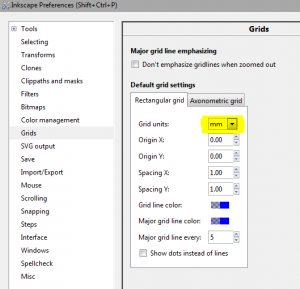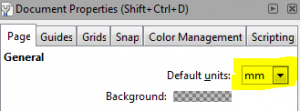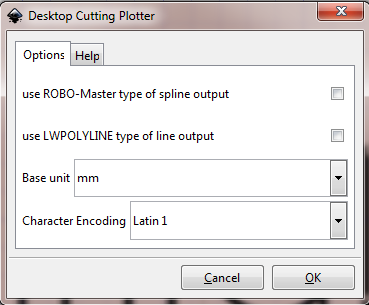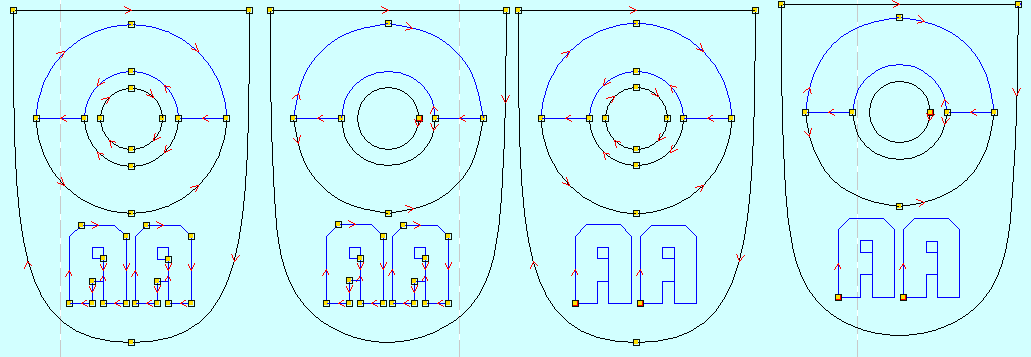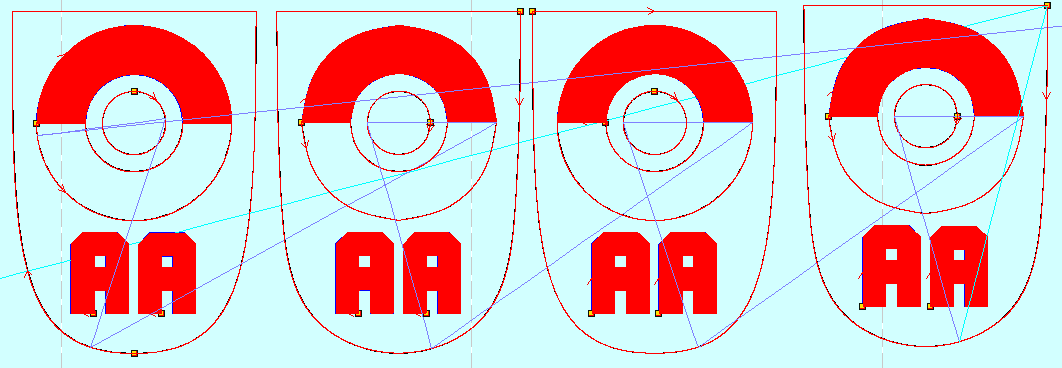Difference between revisions of "Inkscape"
m (→Coloured Paths: fix link) |
(→Usage Tips: +extensions) |
||
| Line 67: | Line 67: | ||
You can leave in the SVG embedded images (eg; jpegs you are tracing) and the DXF file will simply exclude them when it is created. You can check the import in the Laser Cut demo or by opening the DXF file again with Inkscape. | You can leave in the SVG embedded images (eg; jpegs you are tracing) and the DXF file will simply exclude them when it is created. You can check the import in the Laser Cut demo or by opening the DXF file again with Inkscape. | ||
| + | |||
| + | == Extensions == | ||
| + | |||
| + | Extensions to Inkscape allow you to use tools other people have made to create good laser-compatible items. | ||
| + | |||
| + | === Hershey Font === | ||
| + | |||
| + | [http://www.evilmadscientist.com/2011/hershey-text-an-inkscape-extension-for-engraving-fonts/ Hershey fonts] are for engraving nicely on laser cutters. That page details how to install and use them. A mirror will be added here at some point. | ||
| + | |||
| + | === Tabbed Box Maker === | ||
| + | |||
| + | Boxes are a big thing for laser cutters. Everyone makes boxes. We love them. [http://www.keppel.demon.co.uk/111000/111000.html Tabbed Box Maker] helps make nicely tabbed boxes of all kinds. | ||
== DXF file export settings == | == DXF file export settings == | ||
Revision as of 10:53, 28 May 2014
Installation
Inkscape is a brilliant tool for creating SVG files to later use for laser cutting. The download page shows you the installer files for your system; note for a slight increase of speed for complex files on 64bit systems use the Partha builds.
Setup
Grid Setup
Inkscape by default works in pixels as the measurement; for the grids and page size. First of all to change the grids go to the Inkscape Preferences (File -> Inkscape Preferences), under the Grid section select "mm" instead of the default "px". This affects all new files, so select File -> New to open one, and go to View -> Grid to see it in action.
In addition it may be useful to have the snapping turned on for Snap to cusp nodes on the right hand side. What this will do is allow the nodes you've created (such as corners) to snap to the MM grid for more precise tuning. Usually you'll want your actual lines you're drawing to be reasonably thick to be able to see them more easily - in the Laser Cut 5.3 program they become very thin.
Document Settings and Templates
By default Inkscapes default file will be in pixels with an A4 portrait size. The easiest option to create one using millimetres is to select A4 Landscape from the New menu. You can also change a documents units setting any time under File -> Document Properties and selecting mm instead of px for the Default units.
You may also be interested in templates for various sizes of material. If you save these to your Inkscape templates folder (under Windows: %appdata%\inkscape\templates ) you can select them from the New menu. If you want to replace the default, rename one of them to "default.svg". This can save a lot of time when creating multiple items! These are all landscape, but you can save whatever basic SVG you want as a new template.
- Laser A4 template (Landscape, 297x210mm)
- Laser A3 template (Landscape, 420x297mm)
- Laser A2 template (Landscape, 594x420mm)
- Laser A1 template (Landscape, 841x594mm)
- Laser A0 template (Landscape, 1189x841mm)
- Laser 1200x900mm template (Landscape) - A0 isn't quite full bed size - note cutting area of the laser is not necessarily to each edge. This template might be required to line up large materials however.
Once your document is set to MM it will import accurately into Laser Cut 5.3.
Usage Tips
Some tips for usage, a full tutorial may come later:
Coloured Paths
Some of the Inkscape colours are exported with the DXF which can be used to mark areas for engraving, different powers or even different orders of cut. Make sure to have the colours match across everything of one type.
Due to the limited DXF colour export (it only does the 7 primary RGB colours) you can use our custom palette for Inkscape.
Generally it is easier to colour engravings as something special, eg:
- Black - cuts
- Blue - engraving areas
- Green - engraving-power cuts
- Others - other things
See the tutorials on Laser Cut for how to use this powerful feature.
Extra Colours?
There are also alternative ways of converting SVG to DXF that may retain more colours. We also have a complete LaserCut palette file which might be useful for this (although it is untested; some of them do not match the AutoCAD DXF colour palette).
Area fills and Layers
You can fill-colour in areas (eg; to show engraving areas) which makes things easier to see, and use layers and transparency to show/hide or overlay different areas. These are all collapsed or ignored when exporting to DXF, which is useful.
Area fill colour also helps determine if a path you've created is really a completed one. A good engrave area is a fully contiguous single line which is joined up to itself, although the DXF export splits the continuous line into one line with two end points which is easily fixed in Laser Cut.
Paths only!
When finishing a file ready to export select the entire document and go to Path -> Object to Path. The only thing a laser understands is paths (lines) and this may catch any you missed if converting an image file over; objects are not supported.
Leave mess in
You can leave in the SVG embedded images (eg; jpegs you are tracing) and the DXF file will simply exclude them when it is created. You can check the import in the Laser Cut demo or by opening the DXF file again with Inkscape.
Extensions
Extensions to Inkscape allow you to use tools other people have made to create good laser-compatible items.
Hershey Font
Hershey fonts are for engraving nicely on laser cutters. That page details how to install and use them. A mirror will be added here at some point.
Tabbed Box Maker
Boxes are a big thing for laser cutters. Everyone makes boxes. We love them. Tabbed Box Maker helps make nicely tabbed boxes of all kinds.
DXF file export settings
You must save what you want in the DXF file format. This format is not as reliable to re-edit so keeping the original SVG is recommended, use File -> Save As Copy to do an "export" to DXF:
The DXF file exports:
- Paths (lines created in your file)
- Colours of paths
It will exclude:
- Embedded images
- Layers
- Transparencies
- Fills
The save options can also help a bit. The main thing is it must be set to mm, and the tickboxes vary the output that is imported. The best default is no tickboxes since in both cases they can cause errors when importing into LaserCut! So use:
You can stop reading now; this section will probably be removed but is for information
The two tickboxes affect how the different paths of the file are split on save.
From left to right:
- No tickboxes - all paths are split (note that this may allow the laser to determine the quickest cutting path better and most of the time is absolutely fine).
- ROBO-MASTER ticked - the splines (curved lines) are smoothed and kept linked - see the circle on this one is slightly "elongated" and not fully round!
- LWPOLYLINE ticked - the straight lines in the A's are not split anymore. In fact the A was created by a long use of the polygon tool in Inkscape and connected together at the end point and imported over perfectly. However later tests with more curved lettering shows it starts to miss out vital line vector points and the Unite tool in LaserCut goes awry.
- Both ticked - both the above occur. It isn't perfect due to the ROBO-MASTER setting making curves less curved however.
Note that in all cases the lines are not perfect (gaps where the splines and straights match up for instance). However after selecting the Tools -> Unite Lines option in Laser Cut provides pretty much the same cut (red line) and engrave (red area) for each one:
Note how the 2nd and 4th picture the circle is not precise!
The main thing to watch with this design was there are 2 cut lines at the bottom lines of the top engrave; these seem to have been united properly on all designs.
However more complex designs using same-colours for some overlapping lines may cause issues if the Unite Lines tool attaches the wrong nodes together (How does it determine what gets linked at a junction?), so the tickboxes would potentially solve some of these. Best bet is to use no tickboxes.
